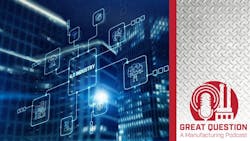Podcast: From lean tools to problem solvers — the new role of leadership in Industry 5.0
Key takeaways
- Industry 5.0 blends lean with human-centered innovation, shifting focus from efficiency to engagement and purpose.
- Tech tools like AI aid training, but leaders must coach critical thinking and real-world application.
- Lean success hinges on building problem solvers, not just teaching tools—mindset matters more.
- Underutilized talent is waste; empowering workers unlocks true continuous improvement potential..
Industry 4.0 advocates talk about the need to manage workers differently, but the thrust of the movement is machine learning, data collection, data-based decision modeling and data-driven process improvement.
So, where do people have a say? To Sarah Tilkens, a former GE Healthcare lean guru who now runs the KPI Lab, that’s why we need Industry 5.0. “The problem (with Industry 4.0) is with the focus so much on productivity and efficiency. People became really, really burned out and disengaged,” Tilkens said. “So, a lot of the systems became very rigid. They weren’t as flexible. They weren’t as creative. And I think that’s what led to… Industry 5.0, which again is all around human led innovation.”
Tilkens shared her thoughts with IndustryWeek editor Jill Jusko, someone who’s spent 25 years writing about continuous improvement and operational excellence.
Below is an excerpt from the podcast:
IW: What does Industry 5.0 look like to you, Sarah?
ST: I have to give credit—I went to a conference in Milwaukee, WI, which is where I’m from—a couple weeks ago. It was put on by Summerfest, it’s our big music festival, but they had a tech and AI conference, and that’s where I learned about Industry 5.0. I hadn’t even realized that we had arrived.
So the way that I think about the difference—because I got super excited and dug in a little bit, like you mentioned—is: Industry 4.0 was all about machines, all about productivity and efficiency, and honestly, getting humans out of places where they’re not creating value.
Some of that is lean, right? Like, we want people to create high value. So if you can get people creating better value by getting them out of monotonous tasks—cool.
I think the problem is, with the focus so much on productivity and efficiency, people became really, really burnt out and disengaged. So a lot of the systems became very rigid. They weren’t as flexible. They weren’t as creative. And I think that’s what led to the birth or the recognition of Industry 5.0, which, again, is all around human-led innovation.
So: focusing on purpose and value, and putting humans back in the driver’s seat of the process instead of machines in the driver’s seat of the process.
IW: And that excited you?
ST: It did excite me. I think for me, lean is just a set of tools. So it is like a hammer, it is like a screwdriver. And I think the real value of the system—and why, at its core, it will never go away—is that it teaches people how to use the tools in the appropriate circumstance.
So: here’s a big toolkit. How do you understand what problem you’re solving, and what you can pull? And I think again, with humans back in the driver’s seat and all of these different algorithms and tools that we can use, it’s just—again—another tool that helps us solve problems and eliminate waste. Quickly. Efficiently. But again, like, towards a means.
IW: So what you had mentioned was: it wasn’t about just doing things faster—it’s about doing things better together. Can you speak to the leadership component? Because you talked about Industry 5.0 as "lean plus leadership."
ST: I think that with 5.0, I can go into my ChatGPT, and I can have ChatGPT teach me a specific tool or a specific skill. What ChatGPT isn’t going to be able to do is help me understand what tool I should use based on the problem that I’m solving.
So I think when we use data and we use information to help us learn skills faster, then it gives us more time to focus on: how do we apply these things? How do we actually solve problems? And how do we build problem solvers?
Instead of telling you what to do, you can go learn what to do—and then my role as a leader is to help you focus on the application, and help you focus on your critical thinking and what you’re learning through the process.
About the Podcast
Great Question: A Manufacturing Podcast offers news and information for the people who make, store and move things and those who manage and maintain the facilities where that work gets done. Manufacturers from chemical producers to automakers to machine shops can listen for critical insights into the technologies, economic conditions and best practices that can influence how to best run facilities to reach operational excellence.
Listen to another episode and subscribe on your favorite podcast app
About the Author
Jill Jusko
Jill Jusko is executive editor for IndustryWeek. She has been writing about manufacturing operations leadership for more than 20 years. Her coverage spotlights companies that are in pursuit of world-class results in quality, productivity, cost and other benchmarks by implementing the latest continuous improvement and lean/Six-Sigma strategies. Jill also coordinates IndustryWeek’s Best Plants Awards Program, which annually salutes the leading manufacturing facilities in North America.
